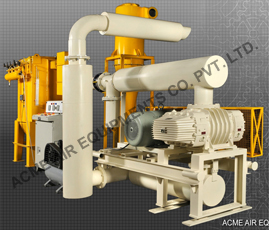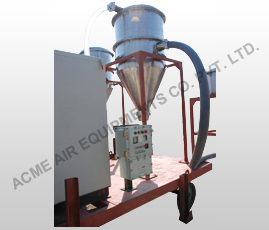Table of Contents
In industrial environments, Dust Collection System is an essential tool for the removal of contaminant particles. Besides reducing air pollution, they can also act as fire suppression systems. These systems are expensive, though. Here are a few tips to choose a system that meets your needs. Firstly, consider how much work you’ll be doing. Secondly, you should choose a system that can hold a sufficient amount of dust without requiring frequent emptying.
Dust Collection Systems are a Necessity in Industrial Settings
Dust collection systems are vital for industrial settings where dust can affect worker health and safety. They reduce costs and enhance efficiency while improving the work environment. In addition, the systems help facilities meet standards set by the by the different agencies and association.
A dust collection system works by circulating air. It also uses filtration to remove odorous contaminants. Not all systems offer odour reduction, but those that do will use a carbon impregnated filter. A dust collection system can be high or low velocity depending on its capacity. The size and configuration of the system will depend on the type of materials being handled, the type of plants, and the desired levels of performance and safety. Some facilities may only need basic compliance while others will need to meet strict standards set by OSHA and EPA.
While many people are tempted to blow off the dust, savvy plant owners know that even the smallest particles can create big problems. Because of this, many producers are now installing high-end dust collection systems. Cosmetic powders, for example, create significant amounts of dust that can spread throughout the entire production facility. This can pose a serious health risk, but dust collection systems can help prevent these issues.
Proper design and maintenance are essential to a dust collection system’s performance. This includes taking into account the amount of air that needs to be moved, and the amount of static pressure. Other important factors include the temperature and the amount of moisture in the air. A thorough inspection can ensure that the components of the system are functioning properly.

Dust Collection Systems Reduce Contaminant Particles
A Dust Collection System can help to control contaminant particles in the air. The efficiency of these systems depends on the type of particles they are designed to capture and control. The size and weight of particles affects the effectiveness of the filtering system. There are several types of filter systems available.
A good Dust Collection System should have two components. First, it should be effective in capturing nearly 100% of contaminant particles. Second, it should also have a fan that will increase the airflow through it. The fan should also be able to move a high volume of air per minute. A dust collection system should also be designed to minimize static pressure, the amount of air entering the system, and the amount of moisture present in the air.
Another important aspect of a Dust Collection System is compliance with government regulations. Failing to comply with these regulations can lead to significant fines and even closure of the company. Therefore, a Dust Collection System is critical for companies that produce particulate matter. These systems are highly technical and are used in many different types of manufacturing and industrial operations. Their main purpose is to improve air quality and protect workers.
The most common type of Dust Collection System is called the baghouse. The baghouse uses a fan to force the contaminant particles through the filter into a bag. Different types of baghouse systems use different methods for filtering contaminants. The shaker method uses shaking motion to clear the filter, whereas the jet version uses a burst of air when a sensor detects that the filter is full.
Another type of Dust Collection System is called a wet scrubber. This type of system uses droplets of water to separate particulate matter from the air. It contains two whirling blades that saturate the air and then force the watered dust particles into a collection hopper. The watered particles become larger and easier to remove. Some other types of scrubbers include gravity spray towers, cyclone spray chambers, and packed bed scrubbers.

Dust Collection Systems Serve as Fire Suppression Systems
The function of a dust collection system is to reduce airborne particulate matter. The systems do this by using extensive filters. In a fire, the dust collected, and the air used to transport it can be sources of ignition and fuel. Without fire suppression, the fire could spread quickly and cause a significant loss of property and life.
A dust collection system should be equipped with deflagration vents. These vents can direct a fire away from the work environment and minimize the impact of a fire. A deflagration vent opens when predetermined pressure levels are reached. It directs the first wave of the flame and limits the danger.
The safety data sheet for a particular dust collection system contains important information on potential fire fuels. The sheet also contains instructions for the application of a fire suppression agent. Choosing the right fire suppression agent is crucial to ensuring that a dust explosion doesn’t spread to other parts of the system.
Dust explosions can occur in many industries, including manufacturing and woodworking. Sugar refining and coal power generation are other industries that can experience dust explosions. Fire suppression systems are essential in these industries. However, it is also important to note that a dust collection system is non-negotiable. It should be protected at all times.
A dust collection system also needs to be equipped with spark arrestors. A spark arrestor can prevent fires by lowering the temperature of heated particles before they enter the dust collection system. Generally, these devices are installed inside a building. Spark arrestors also help in preventing explosions, so the fire suppression system must contain sparks and channel them away from the building. The dust collection systems are an integral part of many manufacturing and industrial operations.
Cost of Dust Collection Systems
Dust Collection Systems are expensive to buy and install. However, they will last 10 times longer. The main difference is that dust collectors have heavy-duty induction motors, this makes dust collectors a better investment for businesses that operate eight hours a day.
When buying a dust collector, make sure you choose the right one for your particular needs. You need to consider the size of your work area and how much dust you’ll be collecting. You also need to consider the dust collection hose and duct design. These will affect performance and safety.
One factor that can significantly increase the cost of a dust collector is the air-to-cloth ratio. This number depends on the volume and size of the particulates. Higher ratios are required for applications with heavy particulate loads, while lower air-to-cloth ratios are needed for low-volume applications. However, if you need a dust collector that can filter small amounts of particulate matter, consider going with a lower air-to-cloth ratio.
Besides reducing the amount of dust that is released into the air, a good dust collector will also control the amount of exhaust gases. A good dust collection system will reduce this amount by up to 50%. By using the right filter, your business will not only improve the air quality, but also save money.
The Bottom Line
A dust collection system is essential to ensure a hygienic work environment and a safe workplace for employees. It helps prevent hazardous conditions and protects the quality of products produced.



